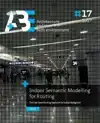- Engels
- Study
- nature & science
- technische wetensch.
- bouwkunde
- INDOOR SEMANTIC MODELLING FOR ROUTING
LIU, LIU
INDOOR SEMANTIC MODELLING FOR ROUTING
39,95incl BTW
Vertrouwd sinds 1927
Persoonlijke aandacht en advies
Vanaf 17,50 gratis verzenden NL & BE
Meer dan 150.000 artikelen online
Omschrijving INDOOR SEMANTIC MODELLING FOR ROUTING
Humans perform many activities indoors and they show a growing need for indoor navigation, especially in unfamiliar buildings such as airports, museums and hospitals. Complexity of such buildings poses many challenges for building managers and visito
rs. Indoor navigation services play an important role in supporting these indoor activities. Indoor navigation covers extensive topics such as: 1) indoor positioning and localization; 2) indoor space representation for navigation model generation; 3)
indoor routing computation; 4) human wayfinding behaviours; and 5) indoor guidance (e.g., textual directories). So far, a large number of studies of pedestrian indoor navigation have presented diverse navigation models and routing algorithms/methods
.
However, the major challenge is rarely referred to: how to represent the complex indoor environment for pedestrians and conduct routing according to the different roles and sizes of users. Such complex buildings contain irregular shapes, large
open spaces, complicated obstacles and different types of passages. A navigation model can be very complicated if the indoors are accurately represented. Although most research demonstrates feasible indoor navigation models and related routing method
s in regular buildings, the focus is still on a general navigation model for pedestrians who are simplified as circles. In fact, pedestrians represent different sizes, motion abilities and preferences (e.g., described in user profiles), which should
be reflected in navigation models and be considered for indoor routing (e.g., relevant Spaces of Interest and Points of Interest). In order to address this challenge, this thesis proposes an innovative indoor modelling and routing approach - two-leve
l routing.
rs. Indoor navigation services play an important role in supporting these indoor activities. Indoor navigation covers extensive topics such as: 1) indoor positioning and localization; 2) indoor space representation for navigation model generation; 3)
indoor routing computation; 4) human wayfinding behaviours; and 5) indoor guidance (e.g., textual directories). So far, a large number of studies of pedestrian indoor navigation have presented diverse navigation models and routing algorithms/methods
.
However, the major challenge is rarely referred to: how to represent the complex indoor environment for pedestrians and conduct routing according to the different roles and sizes of users. Such complex buildings contain irregular shapes, large
open spaces, complicated obstacles and different types of passages. A navigation model can be very complicated if the indoors are accurately represented. Although most research demonstrates feasible indoor navigation models and related routing method
s in regular buildings, the focus is still on a general navigation model for pedestrians who are simplified as circles. In fact, pedestrians represent different sizes, motion abilities and preferences (e.g., described in user profiles), which should
be reflected in navigation models and be considered for indoor routing (e.g., relevant Spaces of Interest and Points of Interest). In order to address this challenge, this thesis proposes an innovative indoor modelling and routing approach - two-leve
l routing.
Leesfragment
Specificaties
- MerkBK Books
- GroepTECHNISCHE WETENSCH (950)
- Barcode9789492516930
- LeverstatusActief
Reviews
0.0/5.0
Gemiddelde uit 0 reviews
Meest behulpzame reviews
Nog geen reviews geschreven


